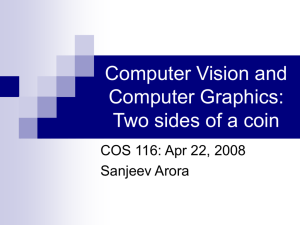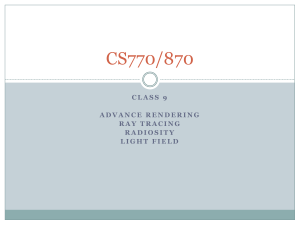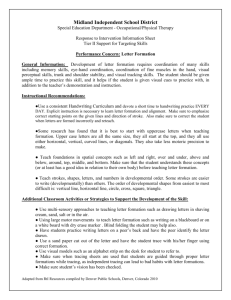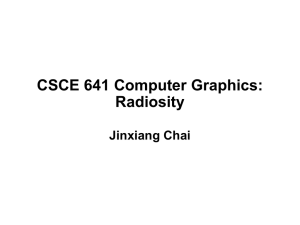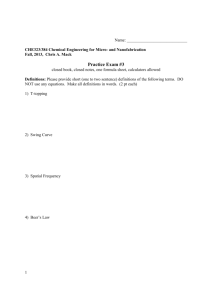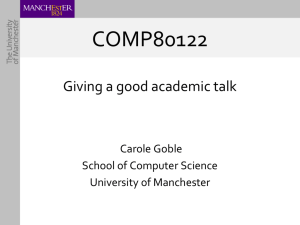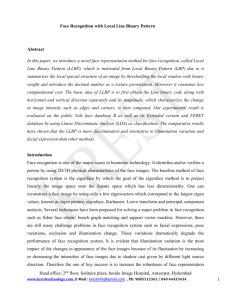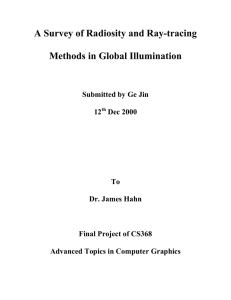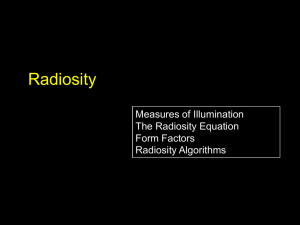01_Overview - Computer Science and Engineering
advertisement
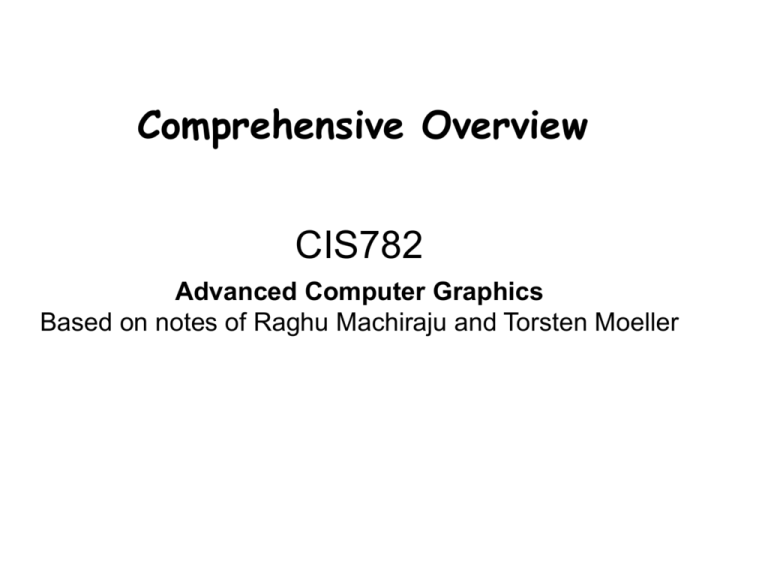
Comprehensive Overview CIS782 Advanced Computer Graphics Based on notes of Raghu Machiraju and Torsten Moeller Realism Through Synthesis Holy Grail © 199? Cheng Zhang Photrealistic (Physically Based) Rendering • Visibility - sampling • camera to surface • surface to surface • surface to light source • Optics • Nature of Light & its Transport • Interaction with surface • Display - resampling • Perception Graphics Pipeline Modeling Transform Visibility Illumination + Shading Perception, Interaction Color Texture/ Realism Review & Looking ahead • Local illumination models • Global illumination • Ray tracing • Light transport equations Shading • Illumination Model: determine the color of a surface (data) point by simulating some light attributes. • Local Illumination: deals only with isolated surface (data) point and direct light sources. • Global Illumination: takes into account the relationships between all surfaces (points) in the environment. • Shading Model: applies the illumination models at a set of points and colors the whole scene. Local illumination: Light & Surface • Usually only considering reflected part specular Light ambient diffuse Light=ambient+diffuse+specular Tracing Specular Light Path reflected Light absorbed transmitted Light=reflected+absorbed+transmitted Diffuse Light Light © 1995 Foley, van Dam et al. Specular Light © 1995 Foley, van Dam et al. Ambient Light © 1995 Foley, van Dam et al. • • • • IA: ambient light ka: material’s ambient reflection coefficient Models general level of brightness in the scene Accounts for light effects that are difficult to compute (secondary diffuse reflections, etc) Gouraud Shading Flat Shading © 1995 Foley, van Dam et al. Gouraud Shading Phong Shading Gouraud Shading © 1995 Foley, van Dam et al. Phong Shading Physically Based Illumination • Everything so far has been pretty heuristic • Cannot model: – wavelength dependent phenomena – anisotropic behaviors – subsurface interactions of light & material – indirect diffuse illumination – many other physical phenomena (real physics) • Ongoing research - main contributions – Blinn (1977), Cook, Torrance (1982) – Kajiya (1985), Cabral et al (1987) – Hanrahan, Krüger (1993) Physically Based Illumination Torrance-Sparrow L N V H • D - Microfacet Distribution Function – how many “cracks” do we have that point in our (viewing) direction? • G - Geometrical Attenuation Factor – light gets obscured by other “bumps” • F - Fresnel Term – which portion of the incoming light gets reflected? – Grazing Angle ! Cook-Torrance © 1982 Cook, Torrence. For now can do this © 2001 Pixar, Monster’s Inc And This … © 2003, Pixar, Finding Nemo It’s getting better … © 1998 Cornell Program of Computer Graphics Can We Do Better ? © 2004 Pharr, Humphreys And Even Better ? © 2000 Henrik Wann Jensen Holy Grail © 1998 Cornell Program of Computer Graphics Local Illumination Problem What is the intensity of the surface, from the light source, in the direction of the eye? Image plane Eye Global Illumination Problem What is the “intensity” of this surface from all possible directions? Global Illumination (Partial) Solution Radiosity Determine ‘form factor’ percentage element from environment is visible to element being considered Set up equations so that, given light source intensities, compute diffuse-diffuse transfer of light from one surface to another Energy Distribution Energy Distribution © 1994 by John Mardaljevic – Radiance Software Measure It! Equipment in the Light Measurement Laboratory (circa 1995) of the Cornell University Program of Computer Graphics Light Transport Equation Outgoing radiance from specific point at specific direction Integrated over all possible incoming directions Emitted radiance differential solid angle Bidirectional reflectance distribution function (BRDF) Incoming radiance to specific point in specific direction Challenges • Complex primitives: area lights, materials, shapes • Materials – Interfaces: reflectance and texture – Medium: scattering • Camera - sampling • Large number of paths that light can take • Solutions: – Radiosity - Finite Elements – Ray Tracing - Monte Carlo - random sampling Framework © 1997 Cornell Program of Computer Graphics Global Iillumination - path notation • At a point incoming light may be scattered or reflected diffusely or specularly and may have come from a multitude of interactions itself. • For pairs of surfaces we have 4 possible transfers of light: – diffuse to diffuse transfer – specular to diffuse transfer – diffuse to specular transfer – specular to specular transfer Global Illunimation - path notation • Radiosity: diffuse to diffuse • (Whitted) ray-tracing: specular to specular • string notation (Heckbert 90): – L - light source – E - eye point – path: specify transfer mechanism – 4 possibilities: DD, DS, SD, SS Global Illumination - path notation © 1999 Alan H. Watt Global Illumination - path notation • Path of ‘complete’ algorithm: L(D|S)*E • e.g., LDE, LSE, LDDDE, LDDSDDE, • local reflection model: L(D+S) • typical Z-buffer: L(D+S)E - string of length 1 • LDE+LSE Global Illumination (Whitted) ray tracing • Traces light rays in reverse direction • light rays specularly reflected • hence is view-dependent • for each hit point we include the contribution of the direct light before we continue with the reflected (or transmitted) ray Global Illumination (Whitted) ray tracing © 1999 Alan H. Watt Global Illumination (Whitted) ray tracing © 1999 Alan H. Watt Global Illumination (Whitted) ray tracing • Includes direct diffuse reflection (LD), but not diffusediffuse (DD) • restricted to specular reflection • path characterization: – LS*E or LDS*E • rendering equation: – integral over sphere of all possible angles simplifies to two (three) specific directions - light direction and perfect reflected (refracted) ray Global Illumination - Radiosity • Implements diffuse-diffuse • no rays - “patches” interact – scene needs to be divided into “patches” • view-independent – one pass computes light distribution in the whole scene: radiosity – second pass renders one particular viewpoint Global Illumination - Radiosity • Ray-traced with main light turned off • typical for indoor scenes • no diffuse interactions - problem! © 1999 Alan H. Watt Global Illumination - Radiosity • Same scene as before - main light turned off • computed using a radiosity method • scene accounts for diffuse interactions © 1999 Alan H. Watt Test Object - Cornell Box This is the original Cornell box, as simulated by Cindy M. Goral, Kenneth E. Torrance, and Donald P. Greenberg for the 1984 paper Modeling the interaction of Light Between Diffuse Surfaces, Computer Graphics (SIGGRAPH '84 Proceedings), Vol. 18, No. 3, July 1984, pp. 213-222. This simulation of the Cornell box was done by Michael F. Cohen and Donald P. Greenberg for the 1985 paper The Hemi-Cube, A Radiosity Solution for Complex Environments, Vol. 19, No. 3, July 1985, pp. 31-40. Does Radiance Work? © 1998 Cornell Program of Computer Graphics Measured © 1998 Cornell Program of Computer Graphics Simulated Difference © 1998 Cornell Program of Computer Graphics Radiosity indirect light & soft shadows © 1988 Cohen, Chen, Wallace, Greenberg: Radiosity Factory © 1987, Wallace, Cohen, Greenberg: Two Pass Rendering Radiosity Equations Radiosity of element i energy emission of element j reflectivity of element j form factor between element i and element j Radiosity Matrix Approximate form factor using projected hemicube method Cannot do it all • Finite element methods • Not efficient - storage • Meshing problems curved surfaces, hard shadows • Complex effects beyond diffuse Try This ? © 1988 Jensen, Christensen "Efficient Simulation of Light Transport in Scenes with Participating Media using Photon Maps“ Henrik Wann Jensen and Per H. Christensen, Proceedings of SIGGRAPH'98, pages 311-320, Orlando, July 1998 Monte Carlo Ray Tracing? • Distributed Ray Tracing • distribute subsamples in time and space • Path Tracing • incrementally generates paths of scattering events • Metropolis Light Transport • distribute according to function’s PDF • Photon Maps • randomly sample rays leaving the light source • Bi-Directional Path Tracing • trace paths both ways: from camera, from light Monte Carlo Integration Can be about computing integrals • • • Im = Monte Carlo estimate N = number of samples x1, x2, …, xN are uniformly distributed random variables in [a,b] Ray Tracing from eye, from light S S S S D D Photon Tracing Visibility/Ray Tracing L[D]S*[E] LS*[D][E] Deposit photons in the environment Path Tracing D D D D D D Distributed Ray Tracing Path history L[S|D]*E From eye, distribute rays until a light source is hit - save path Bi-Directional Path Tracing Image x1 Light path y2 Shadow rays y0 x0 eye path x2 y1 Combine photon mapping and path tracing Path Tracing http://www.winosi.onlinehome.de/83GMC.jpg Photon Mapping Text of Henrik Wann Jensen Path Tracing – Working ? Often Noisy and Slow ! ©1995 Henrik Wann Jensen "Optimizing Path Tracing using Noise Reduction Filters“ Henrik Wann Jensen and Niels Jørgen Christensen, Proceedings of WSCG95, pages 134-142, Plzen, February 1995 Photon Map • Two Pass • • • • • • • Photon Hits are stored in various resolutions Essentially Monte Carlo Path Tracing No Dependence on Geometry Important Component is Data Structure Caustics, Shadow Rendering - Ray Tracing Algorithm Photon Maps can be large in size Photon Map ©1999 Per Christensen Photon Map at Work Ray Tracing – No diffuse component ©1999 Per Christensen Per H. Christensen. "Faster Photon Map Global Illumination". Journal of Graphics Tools, volume 4, number 3, pages 1-10. ACM, 1999. (Appeared April 2000.) Caustics ©1996 Henrik Wann Jensen "Rendering Caustics on Non-Lambertian Surfaces“ Henrik Wann Jensen, Proceedings of Graphics Interface '96, pages 116-121, Toronto, May 1996 Indirect Illumination © 2000 Henrik Wann Jensen Other Related Topics • Light-surface interaction • Perceptual-based display • Image interpolation • etc. SubSurface Scattering © 2001 Jensen, Marschner, Levoy, Hanrahan "A Practical Model for Subsurface Light Transport" Henrik Wann Jensen, Steve Marschner, Marc Levoy, and Pat Hanrahan Proceedings of SIGGRAPH'2001, pages 511-518, Los Angeles, August 2001 Translucency © 2003 Rui Wang © 2001 Jensen, Marschner, Levoy, Hanrahan Combining With Modeling "Visual Simulation of Smoke" Ronald Fedkiw, Jos Stam, and Henrik Wann Jensen Proceedings of SIGGRAPH'2001, pages 15-22, Los Angeles, August 2001 Image Based Modeling and Rendering Display Limitations © 2001 Richard Sharp Tone Reproductions © 1996 Ferwerda, Pattanaik, Shirley, Greenberg Ferwerda, J.A., Pattanaik, S., Shirley, P., and Greenberg, D.P. (1996) A model of visual adaptation for realistic image synthesis. Proceedings SIGGRAPH '96, 249-258. Photo Modeling
